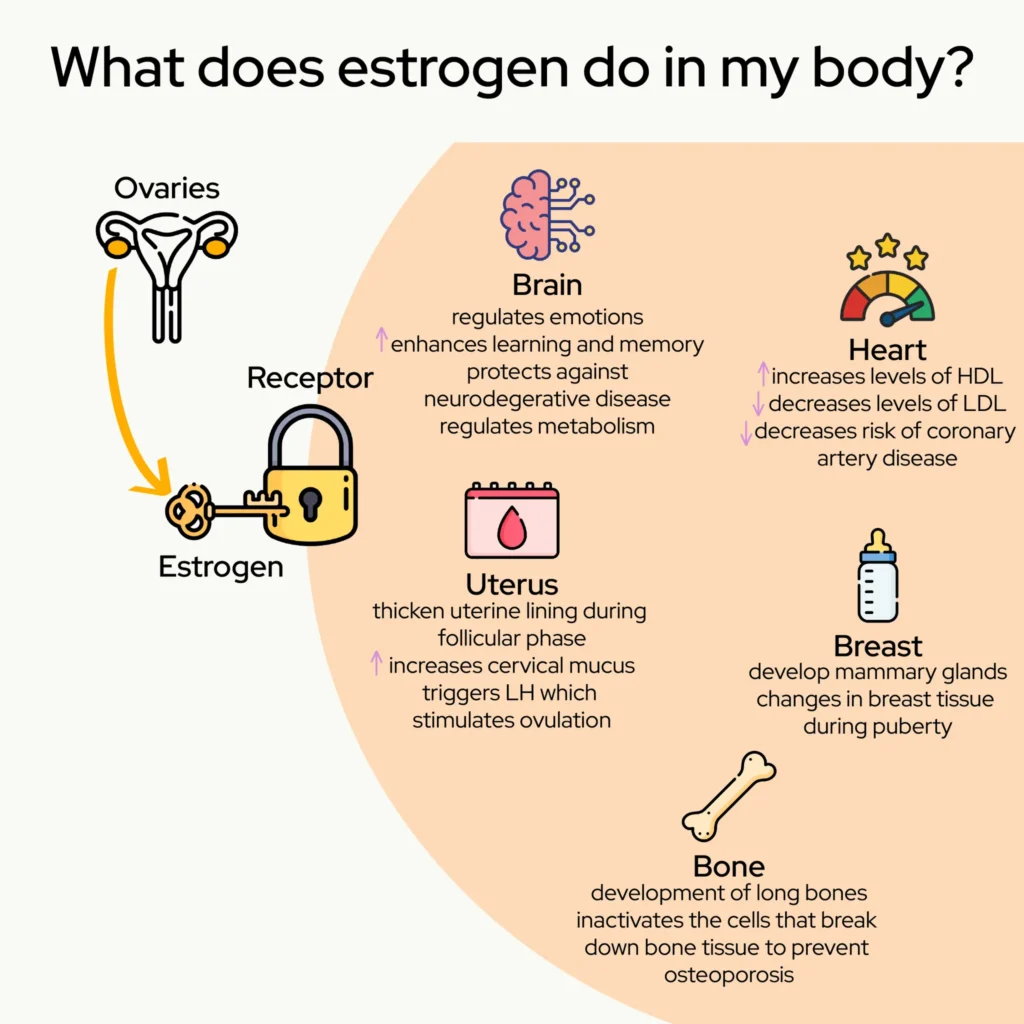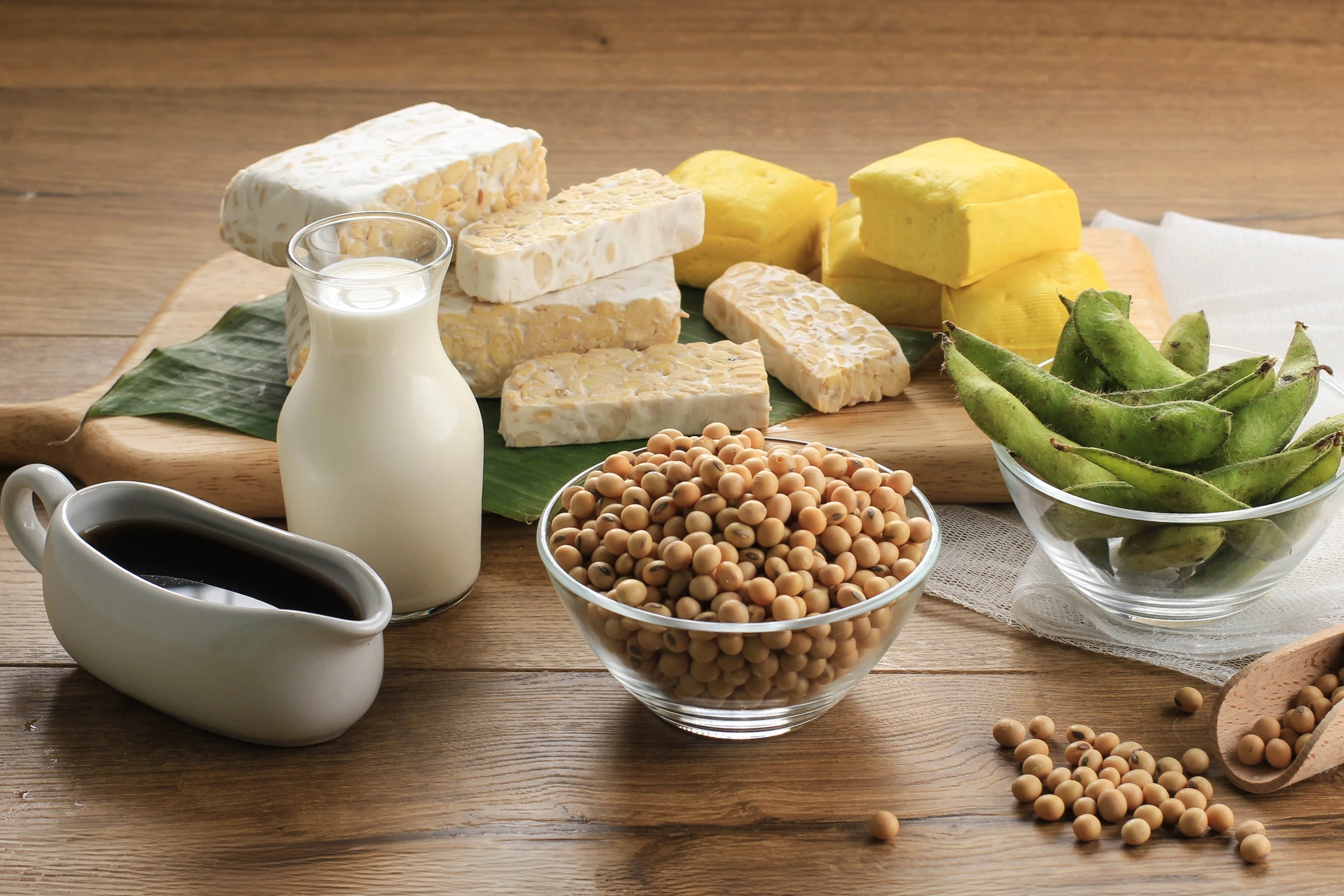“Soy is bad!” We have had numerous patients come to us with this myth. But after much research, it is time to turn the story around and learn about how soy can actually help your body in many ways thanks to phytoestrogens.
What are phytoestrogens?
“Phyto” means plants and “estrogen” is one of the main reproductive hormones in your body. Therefore, phytoestrogens literally translates to “plant estrogens”. These compounds are found in plants and closely resemble the estrogen produced by your own body. These molecules are sisters, not twins: while they have some similarities in shapes, they also have some differences which gives phytoestrogens their unique abilities.
What does estrogen do?
Estrogen is a hormone produced mainly by your ovaries. The way estrogen works inside your body is similar to a lock and key mechanism. The key is estrogen and the locks are called receptors. Once the estrogen lines up with a receptor, it “unlocks” the door and enters the cell. Many cells in your body have estrogen receptors, each one getting a different benefit from having estrogen enter. Primarily, estrogen works to develop female sexual characteristics and regulate your menstrual cycle. To understand the menstrual cycle in a story format, check out our post Understanding Your Period: A Simple Visual Guide. Estrogen also plays a large role in protecting your bones by inactivating the cells that are responsible for breaking down bone tissue. Estrogen can help reduce your risk of heart disease by making sure your cholesterol levels are in check (5).

What do phytoestrogens do in my body?
Phytoestrogens can both increase and decrease the amount of estrogen your body produces. How does this work? Let’s use the analogy of curtains in a room. If the room is too bright, you will close the curtains to limit the amount of light that comes in. If the room is too dark, you will open the curtains to get in more light. Phytoestrogens are analogous the curtains and estrogen is analogous the amount of light. If your body is not producing enough estrogen to satisfy its needs, phytoestrogens can act like estrogen and allow your body to continue functioning. If your body is producing too much estrogen, phytoestrogens will block estrogen from attaching to its receptor, which reduces its activity in the body. For a visual explanation of how phytoestrogens modulate your own body’s estrogen, check out our instagram reel.
How can I increase estrogen naturally in females?
The use of hormone replacement therapy (HRT) has been controversial since it was first introduced in the 1960s (8). Although both phytoestrogens and HRT can mimic your body’s natural estrogen, phytoestrogens are much gentler in their responses. Your body has two different types of estrogen receptors which are located on different organs. Phytoestrogens target the receptors on bone, which increases bone mineral density and prevents risk of fractures (2). Soy-based phytoestrogens have also been linked to a decrease in menopausal symptoms like hot flashes and muscle tension (10). Just 2 servings of soy a day can decrease hot flash frequency by 20% and severity by 25% (3). If you are experiencing menopausal symptoms and want to learn how to navigate the transition through Perimenopause, read our blog Am I in Perimenopause? Symptoms, Signs, and What to Expect. Perimenopause usually starts around ages 45 to 54. If you are experiencing symptoms much earlier, you may be experiencing premature menopause. But don’t diagnose yourself! To understand the causes, risks, and criteria of premature menopause, read our blog What causes premature menopause?
One of the most common misconceptions surrounding phytoestrogens is that soy can cause breast cancer. In fact, soy actually helps to prevent breast cancer. Numerous studies have shown an inverse relationship between soy intake and breast cancer risk, essentially saying that when one goes up the other goes down (8). Phytoestrogens have also been shown to help alleviate estrogen-driven conditions like endometriosis and fibroids. One possible reason for this is that phytoestrogens are anti-inflammatory and prevent excessive cell growth, both of which are key components of endometriosis (9). If you are experiencing painful cramps well before your period, read our post Do I Have Endo? to learn more about the symptoms and how you can get a diagnosis.
Foods that increase phytoestrogens
Phytoestrogens are found in commonly available foods that are easy to add to your diet.
- Soy and soy based products: tofu, tempeh, edamame, miso
- Flaxseeds
- Sesame seeds
- Garlic
- Alfalfa sprouts
Are all forms of soy equal?
The amount of phytoestrogen you actually absorb depends on a multitude of variables. Starting at the source, the phytoestrogen content of plants is based on the season and location (6). How the food is processed also plays a part in how available the phytoestrogens are to your body. The phytoestrogens in fermented foods are easier for your body to absorb, whereas the ones in unfermented foods have to be processed more in your intestine and liver. Examples of fermented foods with soy are soy based yogurts, tempeh, and miso. This logic applies to other phytoestrogen-containing foods as well, not just soy.
A growing field of research is trying to understand why certain ethnic populations have a better response to phytoestrogens than others. This question came about after comparing the Western diet to the Japanese diet and noticing that Japanese women had significantly fewer menopausal symptoms than Caucasian women. One possible theory links your body’s ability to absorb and use phytoestrogens to your gut microbiome. Phytoestrogens are processed in your gut, which means that a healthy gut will be more capable of breaking down the phytoestrogens and releasing them into your body. There is no clear consensus on what exactly to eat to shift your body towards better absorption of phytoestrogens. One study found that a higher intake of polyunsaturated fatty acids (PUFAs) from foods like fish and seeds was linked to better phytoestrogen breakdown in the gut. Omega 3s are one of the main types of PUFAs and are beneficial to many parts of your body. To learn more about how Omega 3s can help reduce painful periods, read our blog post What Should I Eat on my Period?
Based on our practice, we have found that patients who consume more fiber and fermented foods tend to respond better to phytoestrogens. The fiber feeds your gut bacteria and makes them strong and happy to do their job of breaking down compounds like phyotestrogens. The fermented foods are already easier to absorb and use, which means the bacteria have to do less work to get you the benefits. The type of soy consumed also makes a difference. Soy products that are highly processed like soy protein isolate do not have nutrients like fiber or healthy fats with them. If you want to increase your soy intake, try adding minimally processed foods like tofu, tempeh, and soy milk to your meals.
References
- Unfer, V., Casini, M. L., Gerli, S., Costabile, L., Mignosa, M., & Di Renzo, G. C. (2004). Phytoestrogens may improve the pregnancy rate in in vitro fertilization-embryo transfer cycles: a prospective, controlled, randomized trial. Fertility and Sterility, 82(6), 1509–1513. https://doi.org/10.1016/j.fertnstert.2004.07.934
- Nutritionfacts.org. (2016, Nov 25). Who Shouldn’t Eat Soy? [Video]. YouTube. https://youtu.be/vltbg3NUSQs?si=P6rkU5snOJhR_xEX
- Nutritionfacts.org. (2023, Nov 20). Soy Foods For Menopause Hot Flash Symptoms [Video]. YouTube. https://youtu.be/vltbg3NUSQs?si=P6rkU5snOJhR_xEX
- Nutritionfacts.org. (2022, May 20). Friday Favorites: How to Convert into an Equol Producer [Video]. YouTube. https://youtu.be/vltbg3NUSQs?si=P6rkU5snOJhR_xEX
- Delgado BJ, Lopez-Ojeda W. Estrogen. [Updated 2023 Jun 26]. In: StatPearls [Internet]. Treasure Island (FL): StatPearls Publishing; 2025 Jan-. Available from: https://www.ncbi.nlm.nih.gov/books/NBK538260/
- Patisaul, H. B., & Jefferson, W. (2010). The pros and cons of phytoestrogens. Frontiers in neuroendocrinology, 31(4), 400–419. https://doi.org/10.1016/j.yfrne.2010.03.003
- Lilian U. Thompson , Beatrice A. Boucher , Zhen Liu , Michelle Cotterchio & Nancy Kreiger (2006) Phytoestrogen Content of Foods Consumed in Canada, Including Isoflavones, Lignans, and Coumestan, Nutrition and Cancer, 54:2, 184-201, DOI: 10.1207/s15327914nc5402_5: https://pubmed.ncbi.nlm.nih.gov/16898863/
- Boutas, I., Kontogeorgi, A., Dimitrakakis, C., & Kalantaridou, S. N. (2022). Soy Isoflavones and Breast Cancer Risk: A Meta-analysis. In vivo (Athens, Greece), 36(2), 556–562. https://doi.org/10.21873/invivo.12737
- Bartiromo, L., Schimberni, M., Villanacci, R., Ottolina, J., Dolci, C., Salmeri, N., Viganò, P., & Candiani, M. (2021). Endometriosis and Phytoestrogens: Friends or Foes? A Systematic Review. Nutrients, 13(8), 2532. https://doi.org/10.3390/nu13082532
- Aso, T., Uchiyama, S., Matsumura, Y., Taguchi, M., Nozaki, M., Takamatsu, K., Ishizuka, B., Kubota, T., Mizunuma, H., & Ohta, H. (2012). A natural S-equol supplement alleviates hot flushes and other menopausal symptoms in equol nonproducing postmenopausal Japanese women. Journal of women’s health (2002), 21(1), 92–100. https://doi.org/10.1089/jwh.2011.2753
- Bolca, S., Possemiers, S., Herregat, A., Huybrechts, I., Heyerick, A., De Vriese, S., Verbruggen, M., Depypere, H., De Keukeleire, D., Bracke, M., De Henauw, S., Verstraete, W., & Van de Wiele, T. (2007). Microbial and dietary factors are associated with the equol producer phenotype in healthy postmenopausal women. The Journal of nutrition, 137(10), 2242–2246. https://doi.org/10.1093/jn/137.10.2242


